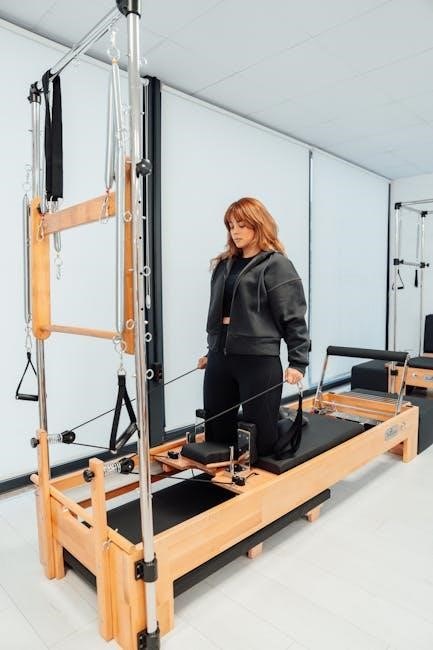Wrist strengthening exercises are essential for improving grip‚ stability‚ and overall hand function. They help prevent injuries and enhance performance in daily activities or sports. Regular practice with tools like resistance bands or dumbbells can significantly boost wrist strength and durability‚ ensuring better control and minimizing pain. Incorporating these exercises into your routine promotes long-term wrist health and mobility.

Understanding the Importance of Wrist Strengthening
Wrist strengthening enhances grip‚ stability‚ and overall hand function‚ reducing injury risk and improving performance in daily activities or sports. Strong wrists support better control and mobility.
Why Wrist Strength Matters
Wrist strength is crucial for maintaining proper hand function and overall upper limb stability. Weak wrists can lead to injuries‚ such as sprains or fractures‚ and hinder daily activities. Strengthening the wrists improves grip‚ dexterity‚ and endurance‚ which are essential for tasks like lifting‚ carrying‚ or using tools. In sports‚ strong wrists enhance performance in activities requiring precise movements‚ like golf or tennis. Additionally‚ wrist strength supports forearm and shoulder health‚ reducing the risk of strain or overuse injuries. Incorporating wrist-strengthening exercises into a fitness routine promotes long-term joint stability and mobility‚ ensuring optimal functionality in both recreational and professional settings.
Common Injuries and Conditions
Wrist injuries‚ such as sprains‚ fractures‚ or repetitive strain‚ often result from weak or unstable joints. Conditions like carpal tunnel syndrome or tendonitis can cause pain and limit mobility. Strengthening exercises help prevent these issues by enhancing wrist stability and endurance. For example‚ wrist sprains can be avoided with improved flexibility and muscle support. Additionally‚ conditions like arthritis benefit from strengthened wrists‚ as they reduce strain and improve joint function. Regular exercises can also aid in recovery from fractures or surgeries‚ restoring wrist mobility and strength. Addressing these injuries and conditions through targeted exercises ensures better long-term wrist health and reduces the risk of future problems.

Types of Wrist Strengthening Exercises
Wrist strengthening exercises include isometric holds‚ resisted flexion/extension‚ weight-based movements‚ and grip-enhancing activities. These exercises target specific muscles‚ improving flexibility‚ endurance‚ and overall joint stability effectively.
Isometric Wrist Exercises
Isometric wrist exercises involve contracting the wrist muscles without moving the joint. These exercises are effective for building strength and stability. One common method is to hold the forearm still while resisting movement with the other hand. This can be done in both flexion and extension positions. Another technique is using a resistance band wrapped around the hand‚ securing the other end under the foot‚ and bending the wrist against the resistance. Isometric exercises are low-impact and can be performed anywhere‚ making them ideal for individuals recovering from injuries or seeking to enhance wrist strength gradually. They also improve muscle endurance and control without putting excessive strain on the joint.
Resisted Wrist Flexion and Extension
Resisted wrist flexion and extension exercises target the muscles responsible for bending and straightening the wrist. To perform wrist flexion‚ hold a light weight or resistance band in your hand with your palm facing up. Slowly bend your wrist upward‚ then lower it back to the starting position. For wrist extension‚ hold the weight or band with your palm facing down‚ and lift your wrist upward‚ then return to the starting position. These exercises strengthen the flexor and extensor muscles‚ improving wrist stability and reducing injury risk. Using resistance bands or light dumbbells is ideal for progressive overload. Start with 10-15 repetitions per set and gradually increase resistance as strength improves.
Weight-Based Wrist Strengthening
Weight-based wrist strengthening involves using dumbbells or small weights to build muscle endurance and power. Sit with your forearm resting on a table‚ palm facing down‚ and hold a light weight. Slowly lift your wrist‚ keeping your forearm still‚ then lower it back. Repeat for 10-15 repetitions. This exercise targets the extensor muscles. For flexion‚ perform the same movement with your palm facing up. Gradually increase the weight as your strength improves. These exercises enhance grip strength‚ improve wrist stability‚ and are beneficial for athletes and individuals with wrist injuries. Consistency is key to achieving noticeable results and preventing future strain or discomfort in the wrist joint.
Dexterity and Grip Strengthening Exercises
Dexterity and grip strengthening exercises focus on improving finger and wrist coordination while enhancing overall hand function. Using tools like squeeze balls or therapy putty‚ individuals can perform repetitive gripping motions to build strength and control. For example‚ squeezing a rubber ball for 5-10 seconds and releasing it can be repeated 10-15 times daily. Finger extensions‚ where resistance bands are used to extend the fingers‚ also promote wrist stability and dexterity. These exercises are particularly beneficial for musicians‚ athletes‚ and individuals recovering from injuries. Regular practice enhances fine motor skills‚ reducing the risk of wrist fatigue and improving performance in daily activities or sports. Consistency is key to achieving noticeable improvements in grip strength and dexterity.

Creating a Wrist Strengthening Routine
A well-structured wrist strengthening routine involves consulting a therapist or instructor to tailor exercises to your fitness level and goals. Begin with simple isometric exercises and gradually incorporate resistance tools like bands or dumbbells. Consistency is key to building strength and improving mobility. Always warm up before starting and cool down afterward to prevent strain. A balanced routine ensures steady progress and reduces injury risk. Regular practice helps maintain wrist health and enhances overall hand function for daily activities and sports performance.
Frequency and Duration of Exercises
For effective wrist strengthening‚ exercises should be performed 3-4 times daily‚ with 10 repetitions per set. Start with shorter sessions and gradually increase duration as strength improves. Consistency is key to building resilience and preventing injuries. Aim for controlled movements to maximize benefits and minimize strain. Over time‚ you can progress to more challenging exercises or increase resistance. Warm-up and cool-down routines are essential to prepare muscles and prevent stiffness. Regular practice‚ even for a few minutes‚ can significantly enhance wrist stability and function. Listen to your body and adjust intensity based on comfort levels to ensure sustainable progress without overexertion.
How to Structure Your Workout Routine
Begin with a 5-minute warm-up‚ such as wrist circles and gentle stretches‚ to prepare muscles and joints. Start with isometric exercises like wrist bends and extensions‚ holding each position for 5-10 seconds. Incorporate resistance bands or light weights for added challenge. Alternate between flexion and extension movements to target all muscle groups. Gradually introduce grip-strengthening activities‚ such as squeezing a ball‚ to enhance dexterity. Finish with cool-down stretches to improve flexibility and reduce stiffness. Adjust the routine based on fitness goals‚ ensuring progression without overexertion. Consistency and proper form are key to achieving strong‚ stable wrists. Listen to your body and modify exercises as needed to avoid discomfort or injury.

Incorporating Wrist Exercises into Daily Activities
Incorporate wrist exercises into daily tasks‚ such as using light weights or household items during chores. Squeeze stress balls or perform wrist bends while working or relaxing.
Using Household Items for Strengthening
Household items like water bottles‚ cans‚ or towels can be repurposed for wrist strengthening. Fill a water bottle with sand or water‚ hold it with an overhand grip‚ and perform wrist bends or extensions. Similarly‚ a can of soup or beans can serve as a light weight for resisted wrist flexion and extension exercises. For added resistance‚ wrap a towel around a sturdy object and pull it gently with your hands to engage your wrists. These exercises are easy to incorporate into daily routines‚ making wrist strengthening accessible without specialized equipment. Consistency is key to building strength and improving wrist function over time.
Exercises for Specific Sports or Activities
Wrist strengthening exercises can be tailored to specific sports or activities‚ enhancing performance and reducing injury risk. For example‚ wrist push-ups are ideal for gymnasts or rock climbers‚ targeting wrist stability and strength. Grip strengthening with squeeze balls or resistance bands benefits tennis players or golfers‚ improving control and precision. Weighted ball exercises‚ such as wrist curls or extensions‚ are effective for racquet sports like badminton or squash. Additionally‚ forearm rolls using light dumbbells or rollers can improve dexterity for musicians or artisans. These targeted exercises help athletes or enthusiasts build the specific wrist strength needed for their activities‚ ensuring better performance and durability over time.

Using Resistance Tools for Wrist Strengthening
Resistance bands‚ dumbbells‚ grip strengtheners‚ and therapy putty are effective tools for enhancing wrist strength and stability. They provide controlled resistance to improve dexterity and overall wrist function.
Resistance Bands and Their Benefits
Resistance bands are a versatile and effective tool for wrist strengthening exercises. They provide controlled resistance to help improve muscle strength and stability. Lightweight and portable‚ resistance bands can be used anywhere‚ making them ideal for home workouts or when traveling. By anchoring the band under a stable object or holding it in place‚ you can perform exercises like resisted wrist flexion and extension. This helps target the forearm muscles and wrist joint‚ enhancing grip strength and dexterity. The gradual increase in resistance levels allows for progressive strengthening‚ catering to different fitness levels. Resistance bands are also cost-effective and space-saving‚ offering a practical solution for incorporating wrist exercises into your daily routine.
Dumbbells and Weight Lifting
Dumbbells and weight lifting are excellent tools for wrist strengthening exercises‚ targeting the muscles of the forearm and wrist. By using light weights‚ you can perform exercises like wrist curls and extensions‚ which help improve grip strength and joint stability. These exercises are easy to incorporate into a routine and can be done with minimal equipment. Holding a dumbbell with your palm facing down or up‚ you can slowly lift and lower your wrist‚ focusing on controlled movements; Weight lifting also enhances muscle endurance‚ reducing the risk of strain during daily activities or sports. Start with light weights and gradually increase as your strength improves‚ ensuring proper form to avoid injury. Dumbbells are versatile‚ making them ideal for both beginners and advanced individuals seeking to strengthen their wrists.
Grip Strengtheners and Squeeze Balls
Grip strengtheners and squeeze balls are versatile tools for improving wrist and hand strength. These devices target the muscles of the forearm and hand‚ enhancing grip strength and dexterity. By squeezing the ball or device‚ you engage the flexor and extensor muscles‚ which are crucial for wrist stability. Grip strengtheners are ideal for both rehabilitation and general strengthening. To use them effectively‚ hold the device in your palm and squeeze slowly‚ holding for 5-10 seconds before releasing. Repeat 10-15 times per session; Start with softer resistance for weaker grips and progress to firmer options as strength improves. Regular use can significantly enhance your ability to grip and control objects‚ reducing the risk of wrist fatigue and injury.
Therapy Putty for Wrist and Hand Strength
Therapy putty is a versatile and effective tool for enhancing wrist and hand strength. This flexible material allows for a variety of exercises that target the muscles of the forearm‚ wrist‚ and fingers. By manipulating the putty through squeezing‚ stretching‚ and shaping‚ you can improve grip strength‚ dexterity‚ and endurance. Exercises such as finger bends‚ finger spreads‚ and palm presses are particularly beneficial. Therapy putty is lightweight and portable‚ making it ideal for daily practice. It is widely used in rehabilitation and is also suitable for individuals seeking to strengthen their wrists and hands for sports or everyday activities. Regular use can enhance overall hand function and reduce the risk of injury.

Advanced Wrist Strengthening Techniques
Advanced techniques include wrist push-ups and plyometric exercises to enhance strength‚ power‚ and stability. These exercises challenge the wrists beyond basic movements‚ improving functional strength and endurance for demanding activities.
Wrist Push-Ups and Plank Variations
Wrist push-ups are a challenging yet effective exercise for strengthening the wrists and improving stability. Begin in a plank position with palms flat on the floor‚ fingers spread wide. Lower your body while keeping your wrists straight‚ ensuring proper form to avoid strain. Plank variations‚ such as forearm planks with wrist lifts‚ can also target the wrists. These exercises enhance wrist endurance and strength‚ particularly for athletes or individuals with demanding hand activities. Start with shorter sets and gradually increase duration as strength improves. Focus on controlled movements to maximize benefits and minimize injury risk. Incorporating these advanced techniques into your routine can significantly enhance wrist stability and overall functionality.
Plyometric Exercises for Wrist Power
Plyometric exercises are dynamic movements designed to enhance wrist power through explosive‚ high-intensity actions. These exercises involve rapid wrist flexions or extensions‚ often using light weights or resistance bands. For example‚ wrist extensions with a light weight can be performed by quickly lifting the weight and lowering it‚ focusing on speed and control. Such exercises are particularly beneficial for athletes or individuals requiring quick‚ powerful hand movements. Start with lower repetitions and gradually increase intensity to build explosive strength. Incorporating plyometric wrist drills into your routine can improve reaction time and enhance overall wrist functionality‚ making them ideal for sports-specific training or rehabilitation purposes.

Safety and Precautions
Start slowly‚ warm up‚ and use proper form to prevent injury. Avoid overexertion and adjust resistance according to your strength level. Cool down post-workout.
Starting Slowly and Progressing Safely
Begin with gentle exercises to avoid strain. Start with isometric holds and light resistance‚ gradually increasing intensity. Focus on controlled movements to build strength without risking injury. Use resistance bands or light weights for wrist extensions and flexions. Avoid overexertion and monitor discomfort. Progress slowly‚ adding resistance or reps as comfort allows; Incorporate tools like therapy putty for grip strength. Prioritize proper form to prevent imbalances. Rest between sessions to promote healing. Listen to your body and adjust routines accordingly. Consistency is key‚ but safety always comes first to ensure long-term benefits.
Monitoring Pain and Avoiding Injury
Pay close attention to pain signals during wrist exercises. Mild discomfort is normal‚ but sharp pain indicates overexertion. Stop immediately if pain arises and rest the wrist. Avoid repetitive strain by balancing activity with rest. Use proper technique to prevent imbalances or injury. Warm up before exercises and cool down afterward to maintain flexibility. Listen to your body and adjust routines if discomfort persists. Overexertion can lead to long-term damage‚ so prioritize caution. If pain lingers‚ consult a healthcare professional for guidance. Consistent‚ gentle progress is safer than aggressive training‚ ensuring wrists remain healthy and strong over time.
Incorporating wrist strengthening exercises into your daily routine can significantly enhance your overall hand function and reduce injury risk. By using tools like resistance bands‚ dumbbells‚ and grip strengtheners‚ you can build resilience and improve mobility. Consistency is key‚ as regular practice ensures long-term benefits. Remember to monitor pain and adjust your routine to avoid overexertion‚ seeking professional advice if discomfort persists. With dedication‚ these exercises will help maintain strong‚ healthy wrists‚ supporting both daily activities and athletic pursuits. Embrace wrist strengthening as a vital part of your fitness journey for lasting results and improved quality of life.
